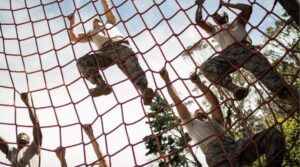Ensuring safety and functionality in sports facilities is crucial, and one of the most effective ways to achieve this is through the use of barrier netting. This essential component plays a significant role in protecting players, spectators, and facilities from stray balls and other projectiles. In this comprehensive guide, we will delve into the various aspects of barrier netting, including its types, benefits, installation considerations, and maintenance tips. By understanding these elements, you can make informed decisions for your sports facility to enhance safety and performance.
What is Barrier Netting?
Barrier netting is a type of safety net design to intercept and contain stray balls, projectiles, and other objects that might otherwise pose a risk to players, spectators, or property. It is a crucial element in many sports, including baseball, soccer, tennis, and golf. Barrier netting helps prevent accidents and damage, ensuring a safe and enjoyable environment for everyone involved.
Types of Barrier Netting
1. Baseball Barrier Netting
Baseball barrier netting is specifically designed to withstand the high-speed impacts of baseballs. Made from heavy-duty materials such as nylon or polyethylene, this netting features a strong mesh that can absorb and deflect the force of foul balls, home runs, and other high-impact projectiles. It is typically installed around baseball fields to protect spectators and prevent damage to surrounding structures.
2. Soccer Barrier Netting
Soccer barrier netting is used to shield spectators and equipment from the powerful kicks of soccer balls. Installed around the perimeters of soccer fields, this netting is made from durable, weather-resistant materials that can endure constant exposure to the elements and high-impact forces. It helps keep soccer balls within the playing area, minimizing interruptions and ensuring a smoother game experience.
3. Tennis Barrier Netting
Tennis barrier netting is designed to keep tennis balls from leaving the court area. It is typically lightweight yet robust, providing effective protection while allowing clear sightlines for players and spectators. This type of netting is often used around tennis courts to prevent balls from straying into adjacent areas, ensuring the game remains uninterrupted.
4. Golf Barrier Netting
Golf barrier netting serves to catch stray golf balls that might otherwise cause damage or injury. Installed behind tees and along fairways and greens, this netting is designed to be functional and unobtrusive, blending seamlessly with the golf course environment. It helps maintain safety on the course while preserving the aesthetic appeal of the surroundings.
Benefits of Barrier Netting
Barrier netting offers numerous advantages that contribute to the safety, functionality, and overall experience of sports facilities:
- Enhanced Safety: Barrier netting provides a crucial safety measure by protecting players, spectators, and property from stray balls and projectiles. This helps prevent injuries and accidents, creating a safer environment for all involved.
- Durability: Construct from high-quality materials, barrier netting is design to withstand harsh weather conditions, high-impact forces, and regular wear and tear. This durability ensures long-lasting performance and minimizes the need for frequent replacements.
- Low Maintenance: Compared to other safety measures, barrier netting requires minimal maintenance. Regular inspections and occasional cleaning are usually sufficient to keep the netting in good condition, making it a cost-effective solution for sports facilities.
- Versatility: Barrier netting can be customized to suit a variety of sports and facility requirements. Whether you need netting for a baseball field, soccer pitch, tennis court, or golf course, there are options available to meet your specific needs.
Installation Considerations
When installing barrier netting, several key factors should be consider to ensure its effectiveness and longevity:
- Material Quality: The quality of the netting material is crucial for its performance and durability. Choose high-quality materials that are UV-resistant, weather-resistant, and capable of withstanding high-impact forces. Nylon and polyethylene are commonly used materials known for their strength and longevity.
- Size and Height: The size and height of the barrier netting should be determine base on the sport and the area to be cover. Accurate measurements are essential for providing adequate protection and ensuring the netting serves its intended purpose.
- Attachment Points: Proper attachment of the netting to stable and robust support structures is vital for preventing sagging or detachment. Ensure that the netting is securely fastened and support to maintain its effectiveness and safety.
- Weather Conditions: Consider the local weather conditions when selecting materials and planning the installation. Netting that can withstand extreme weather conditions, such as strong winds, heavy rain, and intense sun exposure, will have a longer lifespan and perform better over time.
Maintenance Tips for Barrier Netting
Proper maintenance is essential for ensuring the longevity and effectiveness of barrier netting. Here are some practical maintenance tips to keep your netting in top condition:
- Regular Inspections: Conduct periodic inspections of the netting to check for signs of wear, damage, or loose sections. Address any issues promptly to maintain safety and prevent further damage.
- Cleaning: Regularly clean the netting to remove dirt, debris, and other buildup that can contribute to deterioration. Use a mild detergent and water to clean the netting, and avoid harsh chemicals that may damage the material.
- Weather Protection: Protect the netting from extreme weather conditions whenever possible. During severe storms or heavy snowfall, consider covering the netting to prevent damage and prolong its lifespan.
Barrier Netting vs. Other Safety Measures
When evaluating barrier netting in comparison to other safety measures, it’s important to consider factors such as durability, maintenance, visibility, and cost. Here’s a comparative overview:
| Safety Measure | Barrier Netting | Fencing | Screens |
|---|---|---|---|
| Durability | High | Medium | Low |
| Maintenance | Low | Medium | High |
| Visibility | High | Medium | Low |
| Cost | Moderate | High | Low |
Barrier netting stands out as a highly effective and versatile safety solution, offering a balance of durability, low maintenance, and visibility compared to other options.
Contact Us
For more information about barrier netting and to discuss your specific requirements, please reach out to us:
Nets Depot Inc
Phone: (305) 215-5579
Email: [email protected]
Google My Business: Visit our profile
Barrier netting is an essential component in maintaining safety and functionality in sports facilities. By understanding the different types of netting, their benefits, installation considerations, and maintenance needs, you can make informed choices to enhance the safety and performance of your sports environment. Whether you’re looking to upgrade existing netting or install new systems, indeed, investing in high-quality barrier netting will provide lasting value and improve the overall experience for players and spectators alike






